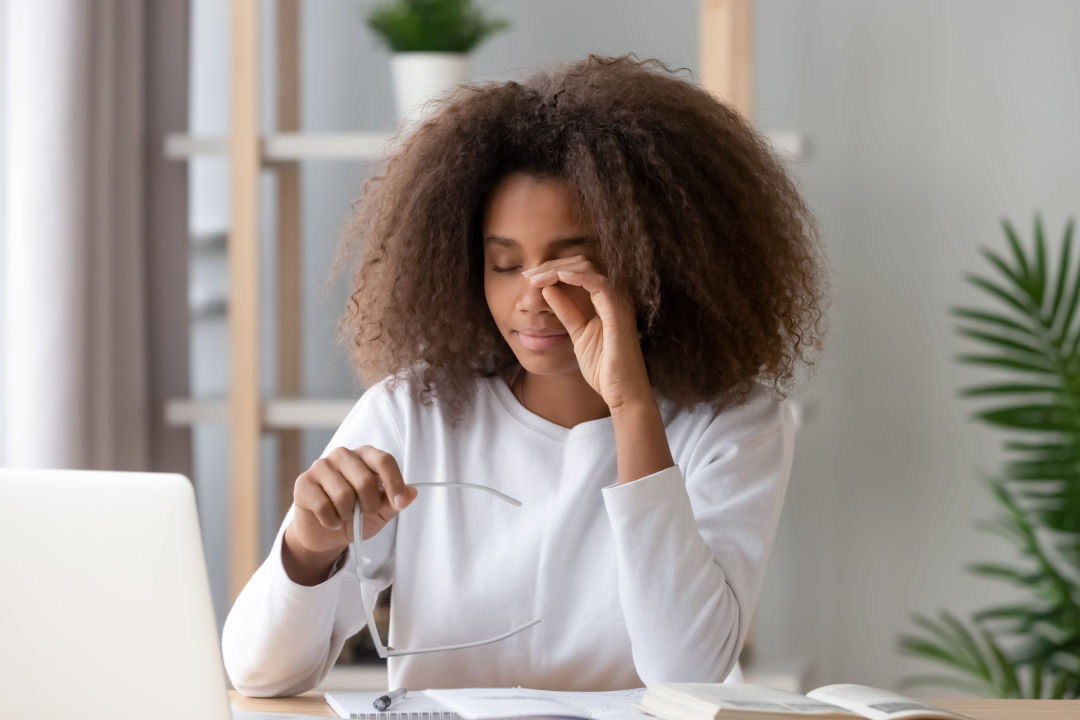Dry Eyes Have Intensified in Lockdown

Image: fizkes/Shutterstock.com
And you thought you stared at your computer too much before the pandemic hit.
There’s seemingly no end to the health problems associated with lockdown life, but the effects on your vision may be something that, ironically, you’ve overlooked. The near-constant screen time—from computers, tablets, phones, e-readers, and, yes, your television, too—is causing an immediate and possibly cumulative disruption in your eyes’ function. Muscle fatigue (from focusing on closer objects) and screen glare both affect the way you’re seeing the world these days, but it’s your tears that you might be missing the most.
Most glaringly, looking at a screen causes a 50 percent or higher reduction in your blink rate. “It overrides the natural blink reflex,” explains Kyle Schaub, an optometrist with Sarasota’s Center for Sight. “Just walking about, you’re going to blink a certain number of times a minute—and that’s pretty close to double the amount of times you’ll blink when you’re staring at a screen.”
Put simply, fewer blinks means less moisture on your eyeball—which sounds uncomfortable enough. But tears are actually an incredibly complex affair, says Schaub. The moisture on your eye itself comprises a “watery part” and an “oily part.” “The oil is on the outer edge, away from the eyeball. The function of that oily layer is to keep the watery layer from evaporating. Every time you blink, a little tiny bit of oil comes out of the eyelid and coats that watery part of the tear.” Without that oily coating, your eyes dry out even faster.
“When you’re blinking less often because you’re staring at a computer screen, you’re going to get intermittent disruptions in your vision,” he adds. “I’ve heard it non-stop for the last six or seven months. People were already using their devices between four and 10 hours a day. I like to joke that now people are using computers up to 27 hours per day.”
This kind of “tear dysfunction” can become cumulative—especially since it doesn’t look like our screen-heavy behavior is going to change any time soon. Still, Schaub does have some recommendations for better eye health, what he likes to call “visual hygiene.”
First and foremost, schedule an eye exam to assess the overall health of your eyes, rule out other chronic dry-eye conditions, and optimize your prescription. Schaub asks that you measure the distance between your forehead and your screen and share that figure with your optometrist. Whatever correction you’re using can be optimized for that distance.
Second, sit as far away from your screen as you can manage. The closer you are, the more your eye muscles will fatigue. And be aware of air-conditioning vents or fans that might create additional drying air current over your eyes.
Third, take breaks. Schaub references the popular 20-20-20 system: Every 20 minutes, take a break for 20 seconds to look at something 20 feet away. Or even better, he adds, “Walk away. Disconnect. Go outside. It’s Florida, so we can.”
And lastly, if you want eye drops, go for lipid-based artificial tears. Schaub recommends Systane Complete, Refresh Optive Advanced, Retaine or Soothe XP. And put the bottle on your desk so you remember to use them three or four times a day. “It’s almost like sunscreen,” says Schaub. “You’ve got to nurse your eyes along.”



